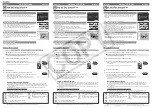
Dictionary Manipulation Statements
Data Definition Language (DDL) Reference Manual — 426798-002
8 -2
DELETE Statement
record-name
is a DDL name that uniquely identifies an existing record in an open DDL
dictionary. You can specify up to 50 records.
token-name
is a DDL name that uniquely identifies an existing token code in an open DDL
dictionary. You can specify up to 50 token codes.
map-name
is a DDL name that uniquely identifies an existing token map in an open DDL
dictionary. You can specify up to 50 token maps.
type-name
is a DDL name that uniquely identifies an existing token type in an open DDL
dictionary. You can specify up to 50 token types.
DELETE Statement Guidelines
The following points are guidelines for using the DELETE statement:
•
Before using the DELETE statement, open the dictionary on the appropriate
subvolume with the DICT command.
•
The DELETE statement deletes a DDL object only from the dictionary; it does not
delete the corresponding entries from any DDL, FUP, or language source-code
files.
•
Before you can delete an object that is referenced by other objects, you must first
delete all the objects that refer to it.
•
Deleting an object that is referenced by another object is more complicated than
deleting an object that is not referenced. For example, deleting a definition can be
more complicated than deleting a record because a record is never referenced by
another record or by a definition. Similarly, deleting a constant or a token type can
be more complicated than deleting a token map or a token code because token
maps and token codes are never referenced by another object.
Deleting a constant is particularly complicated because constants are usually
referenced by a number of different objects.
•
When deleting a constant, a definition, or a token map, you should use the SHOW
USE OF statement to display all the objects that refer to the object you want to
delete. You can use an OUTPUT UPDATE statement to produce DDL source code
that can be used to delete the objects that refer to an object you want to delete.
•
If you do not use the OUTPUT UPDATE statement, you must delete every object
that refers to a specified object before you can delete that object. This includes not
only direct references, in which object B refers to object A directly, but also indirect
















































